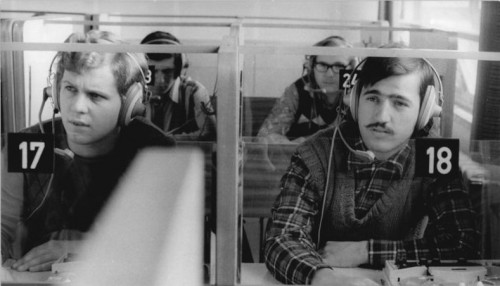Space mattersIn September 2014 (as in a couple of weeks) the new Computing curriculum will come into play in schools in England. Basically this means that ICT as a subject will be replaced by Computing and that students from the age of five will have the opportunity to learn an exciting and powerful new subject. There has been a lot of discussion on how to prepare for this in terms of teacher training. It’s vitally important and it’s why we run Picademy for example. But as the subject matures we also need to start thinking about what an effective computing classroom looks like and how to set it up so that students can get the most from the subject. Teaching and learning spacesMy primary school was not like others. Pupils were free to roam about and do what they wanted. It was an interesting educational experiment. I now know what happens when pupils are responsible for their own education: they smear their faces with woad (well, Crayola indigo warmed up on the radiator) and then scuttle up trees. (Student voice, I'm looking at you.) There were no classrooms in this school of the future, just "bays"—quasi-rooms with no walls, opening onto a central area. It was a terrible environment for most subjects: it’s tricky to concentrate on improper fractions or 'How come the moon doesn't fly off into space?' when the bay across the way is thrashing a class set of percussion instruments like a colony of chimps pummelling the corpse of dead hyena. So I've never been a fan of "learning spaces". Even typing the phrase makes me start rocking gently and keening. And yet learning spaces are exactly what the new English Computing programme of study needs. Walk into a standard ICT suite in any secondary school in the land and you will be stared down by banks of unblinking monitors lining the walls and the central reservations. This is not a learning room, it's a teaching room. It's set out so that teachers can monitor the monitors (and monitor the monitor monitors if they are lucky enough to have them) and control what the students are doing with their hermetically sealed PCs. What they are typically doing, given the closed nature of hardware and software in most of these suites, is usually pretty anodyne. It should come as no surprise that the word “suite” comes from the old French meaning "a group of identically clad followers". This new-fangled ICT thing: it’s a slippery slope and no mistakeSo what the typical student is doing in the typical ICT suite is … ICT. Which is great! Good teachers are running rich and exciting and useful ICT lessons under the old programme of study (PoS). Outstanding teachers have been including elements of computing into their lessons for years (contrary to the belief of those who had never actually read it, the old PoS was pretty flexible and adaptable). But all too often a school’s ICT policy is that the subject should be safe. Not inspiring or useful or thought provoking. Just safe. Which would be lovely if this meant ‘safe’ for the kids, but more often than not it means ‘safe’ for the senior management. ICT isn’t to be trusted: kids obviously needed watching because they might do bad things. Like play games. Or watch games on YouTube. Or write games and pretend to be testing them. Students have even been known to flip screens upside down using hot-keys; or draw rude pictures in Paint and set them as the desktop of their neighbour’s machine; or stick a Post-it on the bottom of the teacher’s mouse; or Google "funny gifs of cats with glok’s and a bom lol!" Hence this urge, especially amongst techno-wary management, to constantly monitor and repress and interfere. Technology that enlightens and frees and encourages experimentation is the same technology that is potentially seditious and disruptive and encourages hacking (hurrah!). So it’s sad but unsurprising that in the current climate schools lock down PCs and stop students from messing about. A more open environment doesn’t require lots of time and money (two big barriers to change in schools) but it does need thoughtful policies and a desire to change. Would you like a handful of magic beans with that interactive whiteboard sir?Of course, if all you want to do is to create things on a screen, then a bank of proprietary PCs does the job (though installing some open source software like Inkscape, Audacity, LibreOffice, Firefox and GIMP wouldn't hurt). But things have changed since the late 90s when IT quietly became ICT and a new curriculum came in: prescribed hardware and proscribed software just aren't good enough now that Computing is back (in retrospect, they weren’t even fit for purpose then). A generic classroom stifles creativity and if Computing is one thing, it’s creative. Looking back at my ten years in an ICT classroom it’s clear to me that most ICT suites are the 21st century equivalent of the shiny new language labs that popcorned into secondary schools in the late 70s: shiny and exciting but ultimately a bit rubbish. My old stock cupboard is full of unused smoke-and-mirrors ICT kit that was sold as the next big thing but turned out to be technology for technology’s sake. (We’re very fond of the old magic beans thing in education, but that’s another blog post entirely.) Technology by itself rarely improves learning. Good teachers in stimulating environments always do. A new classroom for the new programme of studyFor the new Computing programme of study let's give the students the freedom to tinker and to hack and to experiment and to collaborate. And let’s give them the space and the tools to do this. PCs still have a place of course, but ideally there will be a central table(s) full of electronics, robots, sensors, computers, projects kits, stuff you’ve found in skips, printers, bits and bobs, cutters and a runcible spoon. (And, of course, Raspberry Pis!) Let anyone who wants to play come in at break, lunchtime and after school to mess around. Encourage other subjects to use computing as a creative tool, one they can use in their lessons, and to look at Computing and not say "Whatever" but "Hmmm, that's interesting…" (Because if Computing is not used across the whole curriculum then we are missing both the point and a huge learning opportunity.) For this we are going to have to change our ICT rooms from teaching rooms to learning spaces. It’s not a trivial thing and it won’t happen overnight. But if you are offered a new room in which to teach Computing this September, or you get the chance to re-purpose an existing ICT suite, please make it the first thing on your agenda. In fact, make a space like this: In time, ten years perhaps, computing in schools will be a normal tool for problem solving and creativity. Just a tool to do things in the same way that, on a much smaller scale, a calculator is used today in Maths (although the things you can do are very much cooler and more useful than telling your mate to type in ’5318008′ and hand it, upside down, to your teacher). In the meantime, let’s get the learning spaces right. The rest will drop into place. How you can helpWe’re currently writing materials on how to set up a computing classroom and we’d like your help. What would your ideal computing space look like and why? What would you like to see in there, how would it be set up and how could the Raspberry Pi Foundation help you with this? We’d love to hear your thoughts on this and the final materials will be published in our resources area. Comments below would be lovely, thanks! |
A Semi-automated Technology Roundup Provided by Linebaugh Public Library IT Staff | techblog.linebaugh.org
Thursday, August 21, 2014
What does a good computing classroom look like?
Subscribe to:
Post Comments (Atom)




No comments:
Post a Comment